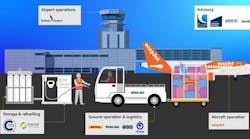In “The Graduate,” the actor Walter Brooke said “Plastics” to Dustin Hoffman. In the 46 years since, we’ve used many variations to attract folks to oil and gas, computers and yes, even aviation. Today that quote is “Energy” – finding energy, developing new generation technologies, bending pipes underground to drill horizontally and even imposing laws to reduce carbon from your local utility to the European EU ETS taking airliner engines to the cleanest standards technically possible. But there are well proven and affordable opportunities right there in your buildings. Energy efficiency is a key to making your buildings do more with less: Less energy, less maintenance and less cost.
According to the Lawrence Berkeley Lab, “Buildings in the U.S. today consume 72 percent of electricity produced, and 55 percent of U.S. natural gas use. They account for about 40 percent of total U.S. energy consumption (costing $350 billion per year) and greenhouse gas emissions.” HVAC alone is estimated by the Oak Ridge National Laboratory to account for 39 percent of this value. It’s clear these are very big numbers in search of a full range of solutions. A simple 1 percent increase in efficiency would result in a dollar savings of over $1 billion annually:
|
US TOTAL |
$ 350,000,000,000 |
|
|
HVAC |
$ 136,500,000,000 |
39% |
|
Savings |
$ 1,365,000,000 |
1% |
In this column we’ll talk about our experience in financing nearly $1 Billion in energy efficiency improvements throughout the United States – turning Cap Ex to savings.
The ESCOs, (Energy Services Companies), and the mechanical and electrical and engineering businesses serving your buildings, break down these opportunities into two categories called FIMs and ECMs – facility improvement measures that improve your buildings not necessarily reducing energy or operating expense; and, Energy Conservation Measures documented to reduce your costs of electricity, gas, water and maintenance or employee hours. The focus is heating and cooling – HVAC; controls and automation; and, Lighting with more involved solutions on a long list. We’ll launch our column with the “go to market” strategy – the Performance Contract – these companies use to improve your facilities at little or no up-front cost to you driving savings in dollars and hours to your bottom lines.
The concept of ESPC, (Energy Savings Performance Contract), is pretty straight forward: By investing X dollars in FIMs and ECMs today, the ESCO will guaranty you a reduction in consumption over Y years. The Holy Grail here is “revenue neutral” where the guaranteed savings are equal to or greater than your debt service as the vast majority of these projects in state and local government are financed using the kinds tax-exempt financing most of your airports can access – and not just bonds but, more on that in another column. Here’s a simple example from a recent $1.465 Million lighting retrofit project:
|
Year |
1 |
2 |
3 |
4 |
5 |
|
Utility Cost Reductions |
$ 256,644 |
$ 256,644 |
$ 256,644 |
$ 256,644 |
$ 256,644 |
|
Total Utility Costs Reductions |
$ 256,644 |
$ 256,644 |
$ 256,644 |
$ 256,644 |
$ 256,644 |
|
Operational Costs Reductions |
$ 160,152 |
$ 160,152 |
$ 160,152 |
$ 160,152 |
$ 160,152 |
|
Total Ops Cost Reductions |
$ 160,152 |
$ 160,152 |
$ 160,152 |
$ 160,152 |
$ 160,152 |
|
TOTAL COST REDUCTIONS |
$ 416,796 |
$ 416,796 |
$ 416,796 |
$ 416,796 |
$ 416,796 |
|
ANNUAL LEASE PAYMENT |
($ 303,998) |
($ 303,998) |
($ 303,998) |
($ 303,998) |
($ 303,998) |
|
TOTAL PROGRAM COST |
($ 303,998) |
($ 303,998) |
($ 303,998) |
($ 303,998) |
($ 303,998) |
|
ANNUAL CASH FLOW: |
$ 112,798 |
$ 112,798 |
$ 112,798 |
$ 112,798 |
$ 112,798 |
In this real example, nearly $564 thousand dollars flowed to the bottom line by changing old inefficient light fixtures in a building while the project paid for itself.
There are lots of considerations we’re going to drill into in future columns – today we’re hoping to whet your appetite and encourage your questions about how you can “do more with less.”
David Clamage is the Managing Director of Saulsbury Hill Financial, LLC, (www.saulhill.com), founded in 1976 as finance specialists in the varied disciplines of ESPC, DG, DHCP, Co-Gen and related Mechanical/HVAC asset types. They are a member of the Energy Services Coalition and a partner with the EPA in re: Combined Heat and Power and the Landfill Methane Outreach Program, as well as a listed financier with the Bonneville Power Administration.




